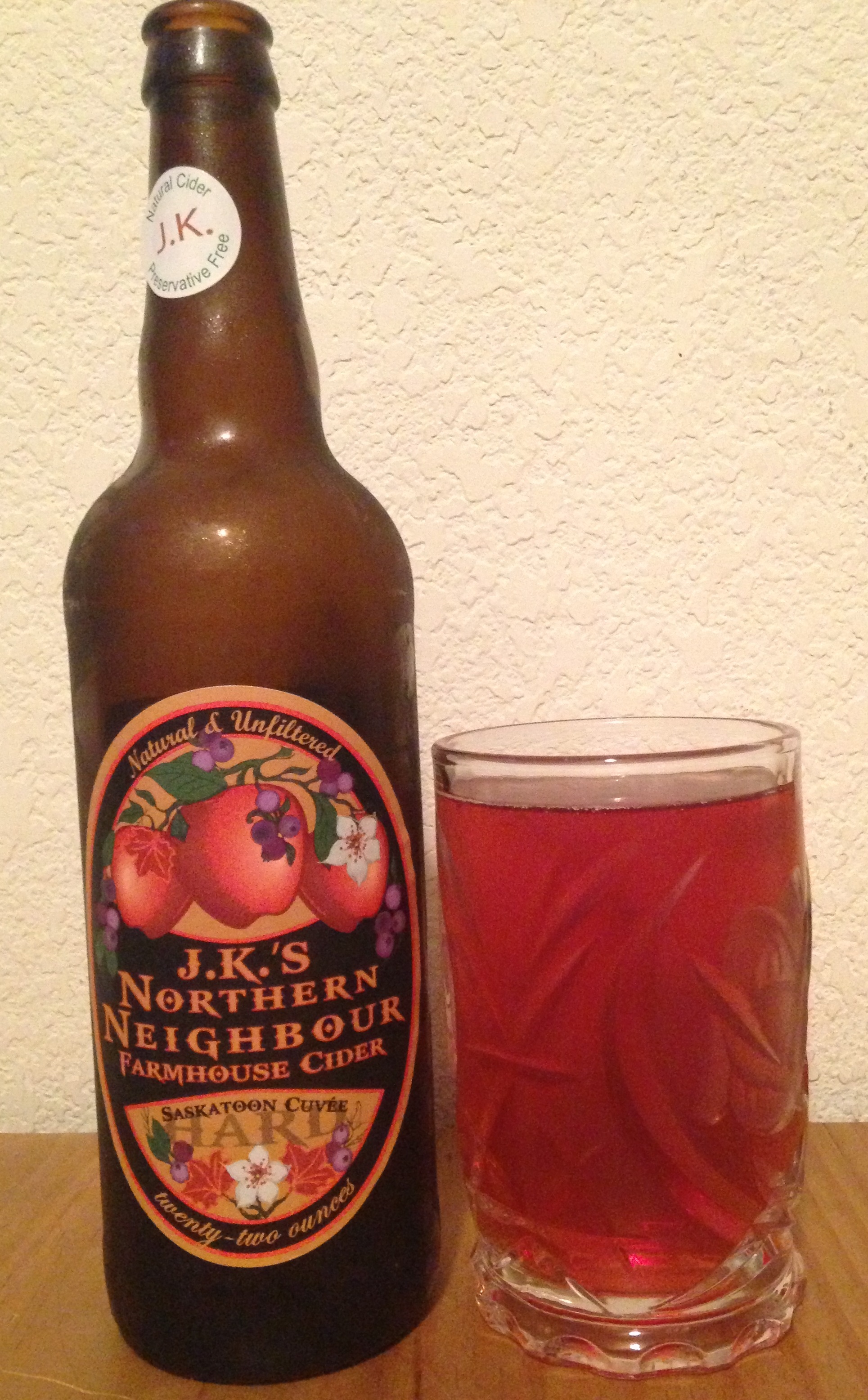Hard Cider Review: JK Scrumpy’s Northern Neighbor

Well, I’ve ruined my cider review strategy already. I had been planning on working my way up through reviews of some of the run-of-the-mill, commercial ciders before moving on to what I consider to be the main event: artisanal ciders made in a localized fashion with quality cider apples of the bittersweet and bittersharp varieties, and without chemical manipulation of the flavor profile. But now that I’ve tried Northern Neighbor, this approach is going out the window, because this review just can’t wait.
I picked up a bottle of JK Scrumpy’s Northern Neighbor—a reference to the Canadian Saskatoon apples that this Michigan-based farm and cidery adds to this cider—for the very mundane reason that it happened to be in the bomber bottle section of my local liquor store, next to a few other ciders. I don’t know what I expected—not much, to be honest—but the second I opened the bottle I was blown away by the intense apple aroma and intrigued by the mystery of this unusual, all-natural cider. Northern Neighbor is a hidden jewel and an exemplar of the all-natural cider-making philosophy.
Unlike most ciders, this one pours pink and has a powerful, bitter snap up front and a heavy sweetness that normally I’d consider to be excessive. The apple profile is absolutely wild, by which I mean it exhibits the characteristics of wild apples…the most well-known of which is the crab apple. I know, I know—crab apple juice is not your idea of a great beverage…but its presence when fermented together with a blend of other apples can be magical. Northern Neighbor is not an insipid blend of sweet, boring table apples, but rather a sharp-edged, complex, tannic, and urgent elixir.
Highly aromatic and a little astringent despite its almost syrupy sweetness—which I now believe is there either by necessity to balance the intensity of wild apple or because there are some more complex sugars lurking in the blend which don’t ferment out fully—the flavor latches on to your palate and doesn’t let go, lingering long after each sip. It’s a relatively low alcohol cider, at 5.5% (versus about 7% in your typical, natural hard cider), so almost none of the bite is from the alcohol.
The real mystery is this—what is a Saskatoon apple? According to the packaging, it’s ‘a unique Canadian prairie apple’. That’s as specific as they get, and of course resulted in further research on my part. This research wasn’t terribly fruitful (har, har), however—while it’s clear that Canadian prairie apples include many varieties that are crab apples. So, likely somewhere in the wild apple spectrum, and likely tannic and bitter (I’ll have to try the other Scrumpy products, which are more centered around the Northern Michigan apples that make up their cider base, to compare as a baseline). I did not, however, find a specific variety called the Saskatoon—whose namesake is likely either the capital city of Saskatchewan or the Saskatoon berry which in turn is that city’s namesake. I did find a giant resource of Canadian Prairie apple cultivars, however, from the University of Saskatchewan. The specific apple will remain a mystery…for now.
In any case, Northern Neighbor is a great example of the diversity of apples out there and the alchemy that is cider blending—it is too easy to think of the typical, store-bought apples (of which there are essentially only two varieties: sweet and tart) as the sum of possibility for apple flavor. As with so many other foods, that thankfully isn’t the case, at least as long as there are dedicated farmers and hobbyists out there preserving and promoting full-flavored, diverse heirloom varieties. Give it a try—I guarantee it will be an enlightening experience.
Here’s a short video describing the cidery:
–
Thanks for visiting The Cidersage Blog. If you found this content to be useful, consider subscribing via the Subscribe link in the side bar, and be sure to visit our resources and tutorials pages for more in-depth hard cider and mead information.
The Saskatoon is most definitely not an apple variety but the berry. It is in the same general family as apples but a distant relative. but it is what gives this cider it’s distinctive color. I heard from another source that J.K. imports barrels of the extract of the berries for use in the product. I haven’t yet tried it but now can’t wait to 😉 I’m from the Canadian prairies and am well familiar with the berries, having picked many on family berry-picking outings in season, and eaten much Saskatoon preserves that resulted.
Thanks for clarifying! I’d love to get my hands on Saskatoon juice (not concentrate, ideally) for my own cider and mead experiments–let me know if you find a source for it that can ship it to the states. The unpasteurized stuff usually ships frozen in my experience.
My own family berry-picking experiences were primarily for Huckleberries in Northern Idaho where my father is from…I remember that–and the flurry of pie and jam-making that followed–being a lot of fun.
Hi
The law has recently changed but prior to 2016 cider was in the “CFR” as being made from pomme fruit. One could use other fermentable fruit, like cherrys as we are in Michigan but it would be taxed as wine not cider. The difference in tax was dramatic. Others ciders have used different fruits in cider but we did not want a knock on the door from uncle Sam years latter. I have a letter from a MI University and one in Saskatoon both saying the Saskatoon berry is a “pomme” fruit. All that aside it lends well to cider and the Canadian farmers have been wonderful to work with.
Hope this helps
Bruce
JKs Farmhouse ciders
Thanks for the context, Bruce!